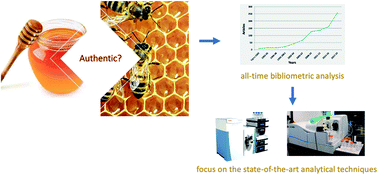Honey authenticity: analytical techniques, state of the art and challenges
Abstract
Honey is a high-value, globally consumed, food product featuring a high market price strictly related to its origin. Moreover, honey origin has to be clearly stated on the label, and quality schemes are prescribed based on its geographical and botanical origin. Therefore, to enhance food quality, it is of utmost importance to develop analytical methods able to accurately and precisely discriminate honey origin. In this study, an all-time scientometric evaluation of the field is provided for the first time using a structured keyword on the Scopus database. The bibliometric analysis pinpoints that the botanical origin discrimination was the most studied authenticity issue, and chromatographic methods were the most frequently used for its assessment. Based on these results, we comprehensively reviewed analytical techniques that have been used in honey authenticity studies. Analytical breakthroughs and bottlenecks on methodologies to assess honey quality parameters using separation, bioanalytical, spectroscopic, elemental and isotopic techniques are presented. Emphasis is given to authenticity markers, and the necessity to apply chemometric tools to reveal them. Altogether, honey authenticity is an ever-growing field, and more advances are expected that will further secure honey quality.

- This article is part of the themed collection: 2021 Reviews in RSC Advances


 Please wait while we load your content...
Please wait while we load your content...